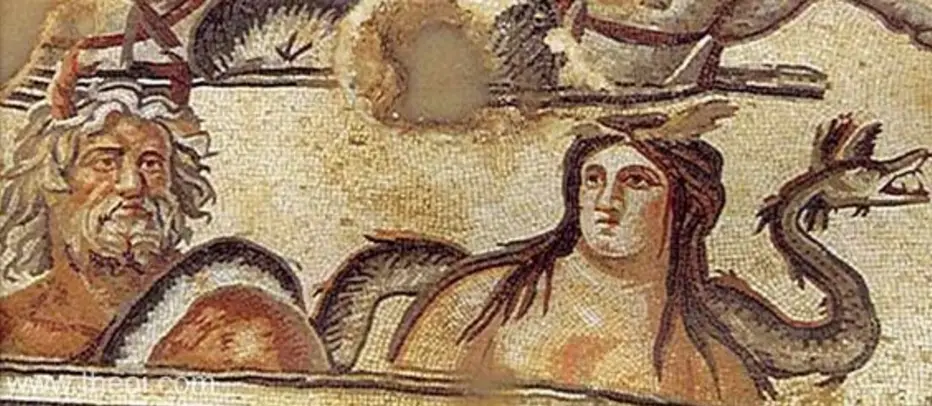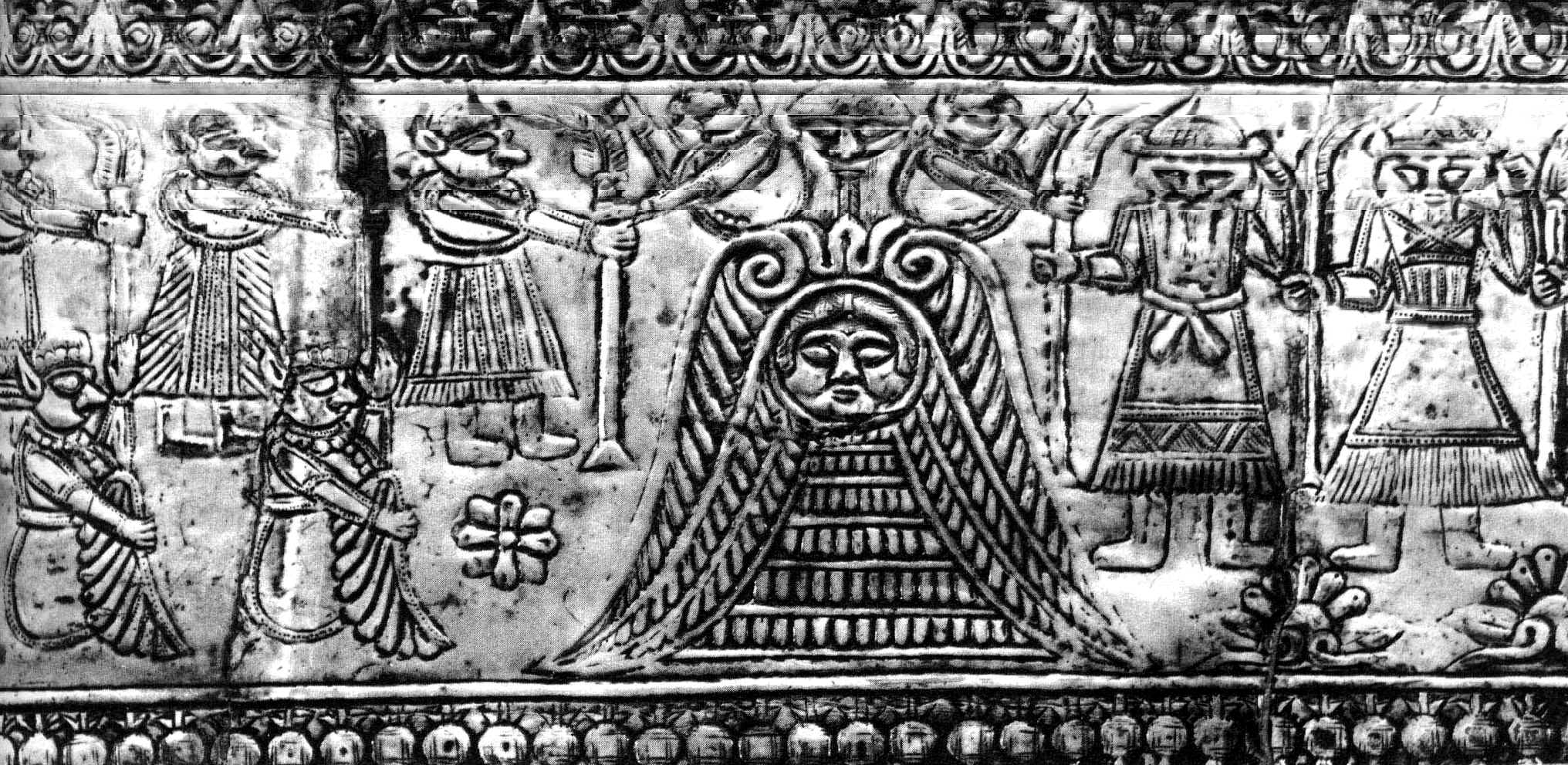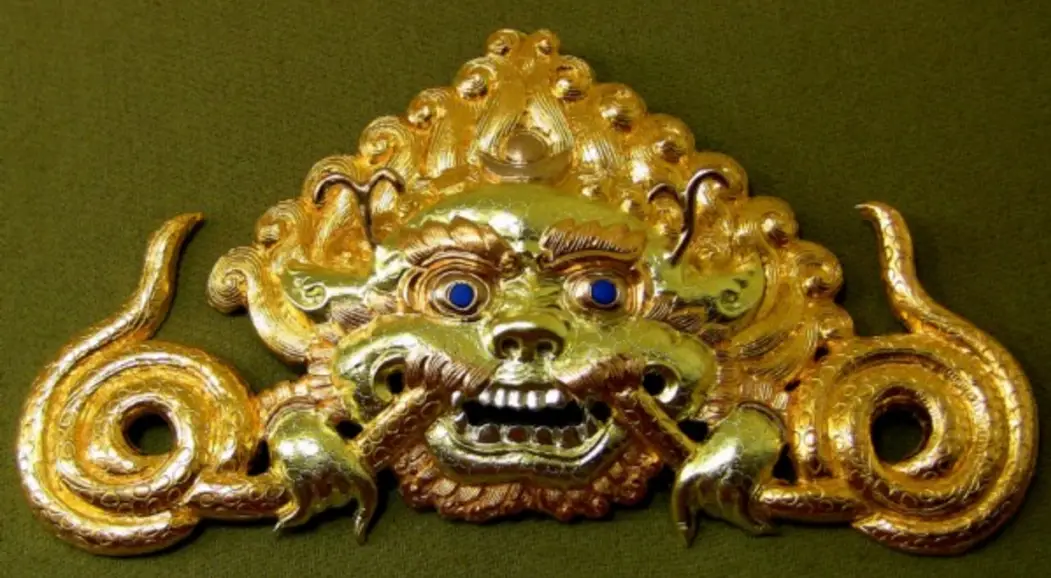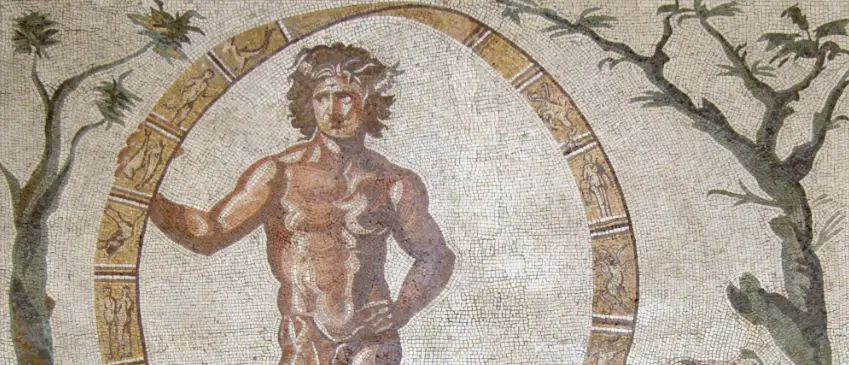di Marco Maculotti
"It is essential to encounter the problem of time. From the perspective of the doctrine of the Cycles it concerns the dead perhaps more than the living. Time expands in all directions forming a circle, [since] it is cyclic."
- Carl Hentze"What is circular is eternal, and what is eternal is circular."
- Aristotle
The ancients had a real obsession with circularity: they conceived the cosmos as a “single vast system filled with gears that contained other gears, enormously intricate in its connections and comparable to a watch with many faces"[Santillana, Decend 74].

OKEANOS, THE "SURROUNDING"
The ancient Greeks initially identified time with Ocean (from Sanskrit achayâna, "The surrounding") [Philipsson 257], the divine river that surrounded the earth as a ring and also included the universe in the form of a circular watercourse or a snake eating its own tail and carrying the zodiac on its back [Franz 10].
The epithets of Ocean in the texts are "Deep-flowing", "ebbing on itself", "tireless", "placidly flowing" and these images "suggest silence, regularity, depth, stillness, rotation" [Santillana, Decend 229]: typical images, as well as of the cosmos, also of Time. Okeanos flows calmly, relentlessly, eternally: his "mighty strength" holds the whole world together. It is the origin of all gods, indeed: of all things [Philipsson 257-8]. Of everything it is there source. "The genesis of everything and of every phenomenon that it encloses in itself, has no beginning or end in its closed circle: on the contrary, such concepts lose all validity in him"[Philipsson 259].
To say it with Serrano, "Although space is not circular, the situation takes place in a Circle, that of theEternal Return and, in a way, it is a reincarnation and a resurrection (...) It is the future that goes back to the past to redeem it"[Serrano 51-2]. In different words, several millennia earlier, Heraclitus conveyed the same esoteric concept in the aphorism [Heraclitus 132]:
"Common [is] the beginning and the end in the circle."
AION AND KRONOS: CYCLIC TIME AND LINEAR TIME
Only in later times the function of god of time was recognized in Kronos: he too was called by the ancient Hellenes "the circular element". In the Saturnalia of Macrobius we read: “Since time is a fixed measure, it is derived from the revolutions of the sky. Time begins there, and from that moment it is believed to have originated from Kronos"[Franz 29]. For the Orphics Chronos was the paredro of ananke, Necessity, which, according to the Pythagoreans, also surrounds the universe. Time and Necessity surround the Universe, like a double circle [Santillana, Dechend 229].
Aion, a deity often associated with Kronos, was considered the god of infinite time, creator and destroyer of everything. The person praying addressed him with these words: "You who consume all things and again you yourself increase them in the opposite direction". Franz recognizes in Aion "an image of the dynamic aspect of existence”, Of what today we could call a« principle of psychophysical energy ». All opposites (change and duration, time and space, light and darkness, life and death, spirit and matter) are enclosed in this primordial cosmic principle. The lion head with which he was often represented, frightening to see, according to Godwin "it implies a destruction, a being devoured, when one is assimilated to the god"[Godwin 194]—That is to say, to put it more clearly, a being engulfed by the god of eternity following physical death on the material plane of reality.
This interpretation is also confirmed by Howard Jackson, according to whom "la lion head, as the quintessence of celestial power, it cannot, then, have been an irremediably oppressive force, but, since it devours souls, it could therefore help them - by initiation and not by compulsion - to free themselves from such incarnation" [Godwin 194].
Cronus and Aion are two manifestations of the same god or, better said, Aion is the primordial manifestation of Kronos, preceding the original partition between space and time, spirit and matter, light and darkness. If, in fact, Aion is infinite time (originally non-separated from space), Kronos is instead finite, cyclical and inexorable time, the bearer of death and destruction (symbolism of the scythe).

ZRVN: TIME AS A CAUSE OF DECADENCE AND DEATH
In the Iranian tradition, the god of time Zrvan (also Zarvan, Zervan, Zurvan) - also divisible into an infinite emanation, akarana, and in a finite, daregochvadhata—it was considered the cause of decay and death and was sometimes even identified with Ahriman, the principle of evil [Francis 12]. However, his worshipers saw him as the source both of Ormadz, the principle of good in the Persian dualism, and of his antagonist Ahriman: he was therefore considered "a god beyond the cosmic circumference and the time we know, which clearly leads one to think of a supra-cosmic divinity" [Godwin 197].
He, exactly like Aion in the Hellenic tradition, was the most powerful, but also "synonymous with death: the death of the macrocosm as well as of the human microcosm" [Godwin 197], that is to say the god of eternity who, just as he absorbs the human soul following its departure from the physical body at the moment of death, so too absorbs the entire manifestation of the world at the end of the Aeon.
THE TWO FORMS OF BRAHMA
Regarding the Indian tradition, it is Coomaraswamy to expose the mystery of the duplicity of time, referring to the god Brahma and stating: "there are indeed two forms of Brahma: time and No-Time (…) what is prior to the Sun is No-Time without parts; but what begins with the Sun is time which has parts, and its form is that of the year"[Coomaraswamy (1) 21].
In the notes, the author states that theatman, the transcendent and immanent solar self, "it is called time (kala) which devours all existences as nourishment" [Coomaraswamy (1) 30]. However, the Hindu deities that interest us most here are others: the god of death and of dharma Yama and above all Shiva, «the Great Destroyer»—e devourer of souls.

SHIVA, THE "TIME THAT EVERYTHING DIVES"
"The whole universe, indeed, is nothing but nourishment and eater"[Brhat Aranyakas Upanisad, 14, 6]
The Hellenic Kronos was, as everyone knows, the god who devours their children. In Vedic India, of Yama, god of death and king of dharma, it was stated: "indeed Yama is death. He is about to devour everything" [Jaiminīya-Brāhamana, I, 28].
Similarly, in the later Hindu tradition, one of Shiva's appellations is Kala Rudra, "The time that devours everything" [Franz 13]. According to śivaita wisdom, everything that is born must die: the principle of life is therefore associated with time, that is, the principle of death; in other words, since life feeds on the death, the creator god is also the destroyer god. For this reason Shiva also has a terrifying aspect (Bhairava) and is called with dark epithets (Rudra, The "Lord of Tears"; Mahakala, The "Time of Time", the "Great Destroyer"): in this capacity, he is venerated above all under the aspect of the energy he manifests: Kālī (from kāla, "time ») the terrible black-skinned goddess. For this reason, Kālī / Durgā "It was erected as" Lady of Time "and of human destinies", as it represents above all the destructive aspect of Śiva, the "Eater of Time" [Sanjakdar 175]. Also the symbolic association between the blue color of the god's skin and the "night as a cosmic network of vital rhythms" it is connected to the eschatological-cosmological value of the figure of Śiva as the "Lord of Time" [Sanjakdar 156].
Furthermore, it should be added that Kala, as well as «time», also means «black, darkened, stained». According to Eliade's exegesis, "time is black because it is hard, irrational, merciless. Those who live under the dominion of time are subject to suffering of all kinds and their liberation consists above all in the abolition of time, in escaping from universal change"[Eliade (1) 189].
Magnone adds: "Who is the Great Instigator (...) if not Kāla, Time, with its personifications: the male Kāla - epithet of Śiva, the annihilating hypostasis of the trimūrti, or appellation of Yama or Mrtyu, the lord of death and hell; and the female Kālī - the dark aspect of the Great Goddess, the energy of becoming running between the poles of life and death, mother and murderer of all creatures?"[Magnone 77].
These sinister peculiarities were also considered typical of Saturn understood in the astrological-astronomical sense, or rather as a planet: astrological symbolism considers it "The Great Maleficent" and he represents him in the form of an old man with a wooden leg and a scythe, with which he reaps the lives of all his children. The same symbolism is found in the astrological tradition of ancient India [Biedermann 466-8].
According to the version of one of the Purāna older, thekali yuga—The dark age we currently live in, governed by the saturnine aspect of the divine found in Kala, the weather is Kāli, the black goddess — is “the age during which time is fully revealed. Indeed VAT it is Time and therefore also represents the intimate essence of Yuga, but it is fully shown only in Kāli, when all beings are "devoured by Time" "[Sanjakdar 130]. Therefore, there is a correlation between the crepuscular attitude of the kali yuga to "absorb" time and the specific function of Śiva / Kronos, which is to periodically reabsorb the cosmos [Magnon 78].
However, Śiva's function as "Great Destroyer" is not merely negative. Coomaraswamy writes: "Śiva is a destroyer, he loves cremation places, but what does he destroy? Not only the heavens and the earth at the end of the cycle, but also the chains that bind each individual soul. Where is the crematorium located and what is it? It is not the place where our earthly bodies are cremated, but the place where the hearts of those who love Him are annihilated and desolated. The place where the ego is destroyed indicates the condition in which illusion and actions are burned: that is the stake, the crematorium field in which it dances"[Coomaraswamy (2) 116].
Śiva, therefore, is "Time as it presides over the manifestation, preservation, and concealment of the cosmos and the liberation of man and therefore also represents the intimate essence of the yugas"[Sanjakdar 136].
The vision of the god who, through the millennia and the Eons, constantly dancing destroys and recreates the cosmos anew, therefore also had a soteriological function: according to Eliade, the simple contemplation of the cosmic panorama formed by endlessly repeating cycles "terrifies man and forces him to convince himself that he must restart this same evanescent existence billions of times and endure the same sufferings without end, and this has the effect of exacerbating his will to escape, that is to push him to definitively transcend his condition of "existing""[Eliade (2) 152].
From the analysis of ancient traditions, it is truly understood how death and life are "the ambivalence in which the mystery culminates, but (...) also the manifestation of the passing of time and the realization of a repeated sacrifice. The progress of life requires death" [Ruini 17]. For this, according to Serrano, "one must learn to dance like Shiva, one day in the light and the next in the shadow"[Serrano 50].

PICTURES OF THE "DIVORATING TIME": T'AO T'IEH E KĀLAMUKHA
The topos of the "devouring time", which we have already documented in the Hellenic tradition (Kronos), in the Persian one (Zrvan) and in the Hindu one (Śiva / Yama), is also found in theprotohistoric Chinese iconography in T'ao T'ieh, an ornamental animal-like mask that Hentze assumed was linked to archaic ideas on becoming [Sanjakdar 112].
The symbols found on this mask are related to an idea of cyclicality, of death and rebirth. T'ao T'ieh it is in fact “equipped with horns buffalo, ram or bull (...) which, next to various spiral motifs, symbolize the crescent moon ", which we know is also a cosmic symbol of cyclical becoming. Hentze deduced that the T'ao T'ieh "è a demon of darkness who creates light and life, also responsible for vital renewal and growth"[Sanjakdar 113].
Reconnecting again to the Indian tradition, we add that Coomaraswamy, quoted by Sanjakdar - whose work for this paragraph we refer to - "establishes a parallel between the aforementioned protocinese demonic mask and the Indian iconographic representation, generally śivaita, known as Kirttimukha ("Face of glory") or Sinhamukha ("Face of the lion")"[Sanjakdar 120], which also links him to the Greek iconography of Aion, god of timeless eternity, who also, as we have seen, he was represented with a lion's face.
We want to report in full this illuminating excerpt from Sanjakdar's work [Sanjakdar 121]:
"Its devouring mouth represents the god of death, Yama, or Kala understood as the solar passage or door to the afterlife; but it also symbolizes the Supreme Being as the radiant sun that dries up and leads to famine, destroys and devours. Her lion mane tends to overlap the image of Śiva's hair as symbols of the sun's rays. While taking on a horrible appearance, as she also represents the demon of eclipses, the Kirttimukha it is dark only in appearance, in reality, in fact this figure is glorifying. On the one hand the mask shows us the transition from life to individual death and cosmic destruction, and from the manifested to the non-manifested, on the other the Kalamukha it is the face of the Supreme Divinity who "assimilates" whoever makes the passage through this narrow door: being devoured by this mythological figure means dying to the world and thus reaching liberation, the mukti".
Also for Coomaraswamy - and we undoubtedly support this hypothesis - it is a question of different divine images connected to thearchetype of the "Devouring God", in full agreement with what we have hypothesized in this essay. Both symbolize "the idea of the Absolute "temporalizing" and "devouring" beings: in fact, the later denomination of the Chinese demonic mask (...) literally means "glutton" or "devourer", just like the Indian "mouth of death", the Kalamukha, a word composed of words Kala ("Time") e mukha ("mouth")" [Sanjakdar 122]. The two masks, therefore, represent the "Devouring Time", which gives life but also death: the supreme identity of opposites or the coincidence of dualisms in a single essence, Aion, the timeless eternity that engulfs all beings subjected to the yoke of time.
In the Italic area, the depiction of the Etruscan god of the afterlife Charun, then "absorbed" in the classical age by the Greek-Roman Charon: "the grinding teeth, on the monuments where they are uncovered by the cruel grin and lips, evoke (...) the image of a carnivore, ready to devour its victims. After killing his victim, Charun accompanies him on his journey to the Underworld, but his function ends at the entrance to the other world, where, if we judge by the scenes painted on the walls of the tombs, the deceased finds a post-existence. full of pleasures"[Eliade (3) 133-4].
Texts cited:
- H. Biedermann, Encyclopedia of Symbols (Garzanti, Milan, 1991).
- A. Coomaraswamy (1), Time and eternity (Mediterranee, Rome, 2013).
- A. Coomaraswamy (2), The dance of Shiva (Adelphi, Milan, 2011).
- M. Eliade (1), Treatise on the history of religions(Bollati Boringhieri, Turin, 1996).
- M. Eliade (2), The myth of the Eternal Return (Boria, Bologna, 1968).
- M. Eliade (3), History of religious beliefs and ideas. Vol. II (Sansoni, Florence, 1980).
- Heraclitus, of the origin, edited by Angelo Tonelli (Feltrinelli, Milan, 1993).
- ML von Franz, The experience of time (TEADUE, Milan, 1997).
- J. Godwin, The polar myth (Mediterranee, Rome, 2001).
- P. Magnone, The dice and the chessboard. Indian visions of time, in Aa.Vv. “Avallon's notebooks. Review of studies on man and the sacred - The sense of time ”, 34 (The circle, Rimini, 1995).
- P. Philipsson, Origins and forms of the Greek myth (Boringhieri, Turin, 1983).
- M. Ruini, introduction to E. Chiavarelli, Diana, Harlequin and the flying spirits (Bulzoni, Rome, 2007).
- L. Sanjakdar, Mircea Eliade and the Tradition. Time, Myth, cosmic cycles (The Circle, 2013).
- G. de Santillana, H. von Dechend, Hamlet's mill (Adelphi, Milan, 1983).
- M. Serrano, Nietzsche and the dance of Shiva (Seventh Seal, Rome, 2013).


19 comments on “Cyclical time and linear time: Kronos / Shiva, the "Time that devours everything""